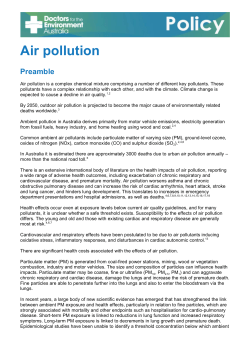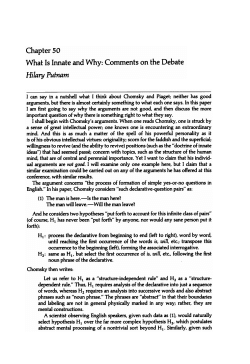
E - N
EPI - NEWS Page 1 of 3 WASHOE COUNTY HEALTH DISTRICT May 3, 2013 Vol. 33, No. 9 In This Issue: Telephone (775) 328-2447 Fax (775) 328-3764 epicenter@washoecounty.us National Air Quality Awareness Week, April 29-May 3, 2013 P.O. BOX 11130 RENO, NEVADA 89520-0027 (775) 328-2447 National Air Quality Awareness Week (April 29 – May 3) Ambient Air Pollution and Human Health National Air Quality Awareness Week (April 29 – May 3) is an annual event to remind the public that they can make an immediate, positive impact on the air we all breathe in our community. The purpose of this article is to provide basic information on air pollution in Washoe County and suggestions you may take to protect your patients’ health. The objectives of this article are: Briefly describe the Ambient Air Monitoring Network in Washoe County; Introduce major air pollutants being monitored daily by the Washoe County Health District (WCHD); Provide a 10 year trend of the Air Quality Index in Washoe County; Introduce the status of attainment for major pollutants in Washoe County; Discuss the association between ambient air pollution and human health; List key recommendations for clinical practice. Figure 1. Washoe County Ambient Air Monitoring Sites (2002-2011) AIR QUALITY MONITORING NETWORK The Air Quality Management Division (AQMD) at WCHD began monitoring ambient air quality in Washoe County in the 1970’s and the monitoring network has grown and evolved since this time. Currently, eight (8) active monitoring sites across Reno, Sparks, Incline Village, and Lemmon Valley (Figure 1) are operating 24/7 to monitor five ambient air pollutants1. AMBIENT AIR POLLUTANTS The federal Clean Air Act requires the Environmental Protection Agency (EPA) to set National Ambient Air Quality Standards (NAAQS) for pollutants to protect public health in the United States, including vulnerable populations. The EPA standards cover six major air pollutants, also known as “criteria” pollutants: ozone (O3), particulate matter (PM), carbon monoxide (CO), nitrogen dioxide (NO2), sulfur dioxide (SO2), and lead (Pb). PM also includes PM10 (particles with aerodynamic diameter ≤10 µm) and PM2.5 (particles with aerodynamic diameter ≤ 2.5 µm). WCHD monitors all pollutants except Pb which is not required based on population size and lack of significant Pb sources in Washoe County. 1 Washoe County, Nevada: Air Quality Trends (2002-2011), May 24, 2012. TEN-YEAR AIR QUALITY TREND The Air Quality Index (AQI) was established by the EPA to inform the public on a daily basis of how clean or polluted the air is, and what associated health effects might be a concern. Members of the public can access the most recent AQI by calling the AQMD air quality hotline at 775-785-4110. Information on the hotline is updated daily or more frequently during air pollution episodes. PM, CO, NO2, and SO2 concentrations are typically higher in the winter months while higher O3 concentrations are more typical during the summer months. The EPA has assigned a specific color to each AQI category (Table 1). Figure 2 summarizes the tenyear trend in AQI between 2002 and 2011. NAAQS revisions in 2006 and 2008 resulted in changes to AQI category ranges and the number of days per year within those ranges. Table 1. Air Quality Index Colors AQI Levels of Health Concern Numerical Value Good 0-50 Moderate 51-100 Unhealthy for Sensitive Groups Unhealthy Meaning Air quality is considered satisfactory, and air pollution poses little or no risk Air quality is acceptable; however, for some pollutants there may be a moderate health concern for a very small number of people who are unusually sensitive to air pollution. Members of sensitive groups may experience health effects. The general public is not likely to be affected. 101-150 201-300 Hazardous 301-500 Washoe, 1 pollutant Everyone may begin to experience health effects; members of sensitive groups may experience more serious health effects. Health warnings of emergency conditions. The entire population is more likely to be affected. Health alert: everyone may experience more serious health effects 151-200 Very Unhealthy Figure 3. Counties Designated “Nonattainment” by EPA, December, 2012 (Source: www.epa.gov) AIR POLLUTION AND HUMAN HEALTH The issue of adverse health effects related to ambient air pollution has been extensively studied and reported worldwide over the past three decades. The Northwestern Nevada including the cities of Reno and Sparks, has undergone rapid population growth in the last two decades and has special geographic characteristics and air pollution patterns. Chen L, et al. conducted environmental epidemiological studies spanning the 1990s for the northwestern Nevada area. Studies concluded that ambient air pollution levels, even when below federal standards, can have a marked potential to impact human health adversely. Studies conducted by Chen et al. and Yang et al. found that: Emergency room visits for asthma was increased with increased daily 1-hour maximum ozone level between 1992 and 1994;2 Hospitalization for chronic obstructive pulmonary disease was increased with increased ambient PM10 concentration between 1990 and 1994;3 Hospitalization for cardio-vascular disease was increased with increased 1-hour maximum ambient CO concentration between 1989 and 1994;4 The ambient ozone level and CO level were positively associated with elementary school absenteeism between 1996 and 19985; and PM10 exposure in the third trimester of pregnancy was a significant predictor of birth weight of newborns between 1991 and 1999.6 (Source: www.epa.gov) Figure 2. AQI Trend, Washoe County, 2002-2011 No. Days per Year Good Moderate USG Unhealthy Very Unhealthy 375 350 325 300 275 250 225 200 175 150 125 100 75 50 25 0 2002 2003 2004 2005 2006 2007 2008 2009 2010 2011 Year (USG=Unhealthy for Sensitive Groups, Source of data: WCHD AQMD) ATTAINMENT STATUS The Clean Air Act requires EPA to designate areas as “attainment” (meeting), “nonattainment” (not meeting), or “unclassifiable” (insufficient data) with respect to the federal NAAQS for each pollutant. Washoe County’s air quality currently meets all federal NAAQS. However, the Truckee Meadows is still officially designated “nonattainment” for PM10 until EPA formally approves the AQMD’s redesignation request (Figure3). 2 Yang W, et al. Air pollution and asthma emergency room visits in Reno,, Nevada. Inhal Toxicol 1997;9:15-29. 3 Chen L, et al. Air particulate pollution and hospital admissions for chronic obstructive pulmonary disease in Reno, Nevada. Inhal Toxicol 2000; 12:281298. 4 Yang W, et al. Cardiovascular disease hospitalization and ambient levels of carbon monoxide. J Toxicol Environ Health 1998; Part 1, 55:185-196. 5 Chen L, et al. Elementary school absenteeism and air pollution. Inhal Toxicol 2000;12:997-1016. 6 Chen L, et al. Air pollution and birth weight in northern Nevada, 1991-1999. Inhal Toxicol 2002:14:141-157. 2 However, these published studies described findings using data in the 1990s7. WCHD began monitoring pollutants such as PM2.5, NO2, and SO2 in the 21st century; therefore, more studies to evaluate the association between ambient air pollution level and human health using recent data in Washoe County may be needed. Regardless of local studies, potential adverse health effects primarily resulting from ozone and PM exposures have been well established and described (Table 2)8 RECOMMENDATION FOR HEALTHCARE PROVIDERS Ozone PM2.5 0.075 ppm (eighthour) 15.0 mcg per m3 (annual) 35.0 mcg per m3 (24hour) PM10 150 mcg per m3 (24-hour) Photochemical reactions between VOCs and NOx Sources of VOCs include gasoline, chemical industry, paints, and consumer products NO x sources mainly from combustion, such as motor vehicle and power plant emissions PM2.5 (particles with aerodynamic diameter ≤ 2.5 μm) such as smoke, soot, and liquid droplets from combustion sources Also includes particles generated by chemical reactions in the atmosphere (secondary organic aerosols) PM10 (particles with aerodynamic diameter ≤ 10 μm) includes PM2.5 particles and larger particles, such as dust and bioaerosols within respirable size range Generated by construction and agriculture activities or suspended by wind All persons living in areas in which air pollutants exceed health-based standards should be aware of the AQI. The AQI is reported daily by the USEPA and WCHD. Monitoring of the daily AQI is recommended for atrisk groups, including those with asthma, chronic obstructive pulmonary disease, or heart disease; children; and older adults. Physicians should advise high-risk patients to reduce exposure to outdoor air pollution when levels are high by spending less time outdoors and avoiding prolonged outdoor exertion. For more information regarding Air Quality Awareness Week, please visit EPA’s website at http://www.epa.gov/airnow/airaware/day1.html or visit AQMD’s website at ourcleanair.com. The American Academy of Family Physicians (AAFP) makes the following key recommendations for clinical practice8: Table 2. Characteristics of Ozone and PM Air Pollution Pollutant NAAQS Sources (Averaging time) Potential Health Effects Susceptible Groups Main Regions Affected Irritation symptoms Reduced lung function Asthma exacerbation Increased mortality Persons with asthma, Urban areas Areas COPD downwind of urban areas US population in nonattainment areas* 132 million Children Older adults Increased all-cause and cardiovascular mortality, including MI, sudden cardiac death, arrhythmia, exacerbation of CHF, and stroke Exacerbation of asthma and COPD Persons with heart disease, asthma, COPD Increased all-cause and cardiovascular mortality, including MI, sudden cardiac death, arrhythmia, exacerbation of CHF, and stroke Exacerbation of asthma and COPD Persons with heart disease, Urban areas Areas 88 million downwind of power plants Children Older adults asthma, COPD Children Older adults and industrial facilities Urban areas Areas 26 million downwind of power plants and industrial facilities Areas with windblown dust * A nonattainment area is a location that fails to meet one or more NAAQS; CHF=Congestive heart failure; COPD=Chronic obstructive pulmonary disease; MI=Myocardial infarction; NAAQS=National Ambient Air Quality Standards; NOx=Nitrogen oxides; PM=particulate matter; ppm=parts per million; VOC=volatile organic compound. 7 Lei Chen and Stanley T. Omaye. Air pollution and health effects in northern Nevada. Reviews on Environmental Health. Volume 16, No. 2, 2001. 8 Robert Laumbach. Outdoor air pollutants and patient health. American Family Physician. January 15, 2010. Volume 81, Number 2, 175-180.
© Copyright 2025





















